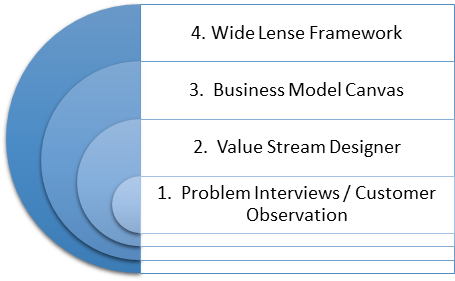Enterprise Lean Startup vs. Startup Lean Startup
 Why is it so difficult for large enterprises to apply innovation techniques and practices? Those giant battleships should be able to squash any competitor in moments. Unfortunately, it is not that simple. These enterprises are successful because they execute incredibly well. They hire and reward employees for their ability to execute.
Why is it so difficult for large enterprises to apply innovation techniques and practices? Those giant battleships should be able to squash any competitor in moments. Unfortunately, it is not that simple. These enterprises are successful because they execute incredibly well. They hire and reward employees for their ability to execute.
True innovation is about searching and learning, about converting guesses into facts. This search requires employees to possess a distinctly different skills and capabilities. They need to be open to the unknown, understand how to learn from failure quickly, and move extremely fast. Additionally, leaders and employees in the organization need to make decisions informed by customer data. Command and control simply does not work in this environment.
Many large organizations today are beginning to embrace the tenets of Lean Startup. In doing so they are learning that the ways in which you apply these techniques in a large organization are very different from the ways they are applied in a startup.
What is different about applying lean startup in the enterprise vs. a startup?
Legal / Branding – Existing enterprises incur significant risk by running experiments with their paying customers. There are existing legal policies in place, as well as the desire to keep from tarnishing the company brand. These facts require that leaders inside the organizations behave differently to be able to innovate effectively within these constraints.
To generate some initial data for these conversations, you will need to run some experiments without approval. Under the cover of night. You don’t need to gather much data, but just enough to influence your legal and branding teams. You’ll need to be able to show them that you can be faster and more effective if you were allowed to run small experiments with customers. The need to get approval from them EVERY time you run an experiment just won’t work.
What Intuit and other companies are doing is to create a set of experimentation guidelines. These guidelines basically give an upper boundary for the number of customers an innovation team an interact with. As long as the team stays within these guidelines the legal team will support their efforts. If the innovation team needs to go outside these boundaries then there is a streamlined approval process in place.
The end goal is to eventually help the legal & branding teams move from frequent “no” answers to frequent “yes” answers so the innovation teams can move ultra-fast.
Human Resources – Behaving like an intrapreneur requires skills that are different from those of a typical enterprise employee. We tend to hire employees for their existing knowledge, tools and processes. We hire them because they have significant domain knowledge that is valuable to the organization.
As you apply Lean Startup and the organization behaves more like a startup, you need to be able to search for a business model that will work. You need natural curiosity, lots of patience, passion and the ability to influence others (without the benefit of positional power).
The ways that you evaluate your employees will be different as well. They will need to be rewarded for taking risks, failing and continuing to move forward. As an organization you’ll also need to determine how you will reward successful new business launches. Will the intrapreneur get to move forward with their business idea or will they have to continue to work in their existing position?
The answers to these questions will be different for every organization. You’ll need to use your new customer empathy skills to determine how your intrapreneurs feel.
Leadership – Your employees are not the only people in the organization that will need to behave differently. This new way of working will significantly impact your leaders as well. Rather than making decisions about the product(s) and keeping the team moving, your leaders will wear the hat of a coach or mentor. They will help to set a product vision, clear the path for their team, ensure the team is running effective experiments and not overlooking key insights.
These new rules of engagement apply whether you are a functional team or a product team. Because they don’t need to focus on making mundane decisions anymore, the leader can now focus on growing the skills of their team members. The are freed up to focus on what is truly important.
Central Sales / Marketing – As your product teams embrace this new way of working, they will handle their own sales & marketing. Remember, they are trying to figure out what works and your existing sales & marketing teams are here to execute something that already works. This creates a clear tension between innovative teams and the teams that support them.
Understanding how to create effective partnerships and touch-points with these supporting teams will make or break your ability to get new products and services into the market quickly.
I’ve seen a few enterprises that have created “catch” teams in their sales & marketing organizations. These teams catch the incoming sales / marketing requests and determine whether the processes have been proven by the requesting team or not. If they have been proven then they can be treated one way, if they have not, then the catch team can help them understand how to search for a working model and even support the innovation team in doing so.
If your sales / marketing organizations keep getting new business ideas that don’t work, the lack of this mindset is likely to blame.
This is by no means an exhaustive list of differences you’ll encounter in the enterprise, but hopefully gets your wheels turning and saves you some time and heartache. Those of us that are implementing this across our enterprises are on the cutting edge and are literally writing history.
Keep the faith!
read moreLean Entrepreneur Value Stream + NPS = Customer Love

As many of you have already seen, I am a strong proponent of the use of the Net Promoter Score (NPS). It is an extremely powerful way to measure the value you’re providing to your customers. NPS helps you measure how often you are exceeding your customer’s expectations and provides a rough gauge to know how many customers may be talking (positively or negatively) to their friends about your product.
During the workshops and coaching sessions I’ve noticed a consistent pattern. Teams have no idea how to actually “delight” their customers (score a 9 or 10 NPS). The net promoter and delight concepts get tossed around like a ragged teddy bears. People understand what terms mean, but have no idea how to make the concept tangible.
Fortunately, Brant Cooper and Patrick Vlaskovits recently released their second book titled “The Lean Entrepreneur”. In this book they introduce a new tool called the Value Stream Designer (I’ll refer to it as VSD for the remainder of this article). I’ve had the pleasure of facilitating some workshops that utilize the tool.
In my opinion the VSD does a great job of helping teams keep from over-building their minimum viable product, hypothesize about what their customer actually expects and determine EXACTLY they are going to build! Additionally it facilitates getting your entire team on the same sheet of music as early as possible which is critical to your ability to be successful. I’m not going to go into detail about the actual mechanics of the VSD as Patrick and Brant already do a great job of covering that in The Lean Entrepreneur. I’ll stay focused on tips and tricks I’ve learned as a result of coaching many teams to use the tool.
Keep From Over-Building by Designing the Minimum Viable Product
Unfortunately, I have yet to see a single team that has been able to focus on building exactly what is necessary to solve their customer’s single problem right out of the gate. They get excited and want to build far more than is necessary. This observation includes many seasoned business professionals and Lean Startup experts. This problem is difficult to see because your team has their noses to the grindstone and are trying to move quickly. The VSD can help you solve this forest for the trees problem.
After you have a basic level of customer empathy; you know what problems you solve for each customer and think you know how your solution will fit into their workflow. I recommend that you print a large wall poster ($10 at Kinko’s) and have your entire team use post-its to fill in the VSD. You should start with the boxes inside the “Satisfied” section and then move on to the “Hopeful” section.

During this process you need to frequently push your team to get very specific about the values they write down. The more specific they can get the better. If it feels uncomfortable then you’re doing it right. Additionally, you should keep in mind that these values are nothing more than hypotheses. Every one of these are guesses that you’ll need to convert into facts using experiments with your target customers.
If you end up being correct about the hypotheses in these two boxes then you should have identified how you can ensure a net promoter score of 7 or 8 (neutral). Customers that make it to this point should have had their expectations met. We will get to the “Passionate” box (NPS of 9 or 10) later in the exercise.
Hypothesize About What Your Customer Actually Expects
As you filled out the “Satisfied” and “Hopeful” boxes on the VSD you will have come across the details of what you should be promising to your customers. You’ve just hypothesized about what impact you can make on them and how you will go about doing it.
You should now continue to move backward through the rest of the VSD (Convinced, Trusting, and Intrigued) and you will begin to dive into the exact touch points where the promises you identified above will initially be placed in front of your customers inside the conversion / sales funnel.
Continue thinking about the promises you had to make in the Satisfied and Hopeful boxes as you fill out the rest of the VSD.
Your final step to complete the VSD is to fill out the boxes inside “Passionate”. This section is typically based on a big insight gathered from watching your customers use your product over time and from experiments you’ve run on those customers. I recommend taking a starting guess about what things you might do to try to create a passionate customer, but it will require many experiments to determine what is actually valuable to the customer.
You now have a map of all of the hypotheses you’re making about the value proposition, funnel and how to actually delight your customer through the product. Additionally, this exercise has a tendency to create shared vision among the team members. Typically teams start out way too high level and it appears that the team has agreement on what they are actually building, but in reality they are all viewing the solution differently.
What about the Business Model Canvas?
One of the most painful things about learning these Lean Startup methodologies is the massive number of tools, frameworks, and puzzles available to teams (entrepreneurs and intrepreneurs). One of the tools that has taken our community by storm is the Business Model Canvas.
We all agree that in the early stages of a new endeavor we are looking for product-market fit. In other words, have we identified a specific customer, problem and solution that complement each other so perfectly that customers begin to pull the product from our hands?

I like to think of the Value Stream Designer as a tool to use to guide our first experiments and stay focused on the riskiest portions of the business model (customer + value proposition). Once you feel confident that your solution will really solve the customer’s problem and you can reliably attract customers then you should move on to looking at the entire business model (business model canvas).
After reducing risk in the larger business model canvas you should move to using the Wide Lens Framework to ensure that you don’t have any co-innovation and/or ecosystem risks in bringing your product to market.
If you can wrap your head about when to use each of these tools then you can safely pull it out of your tool belt at the right time and increase your chances of success. As always, I’d love to hear your feedback. Share how you are applying these tools in your world.
read more






Connect With Me